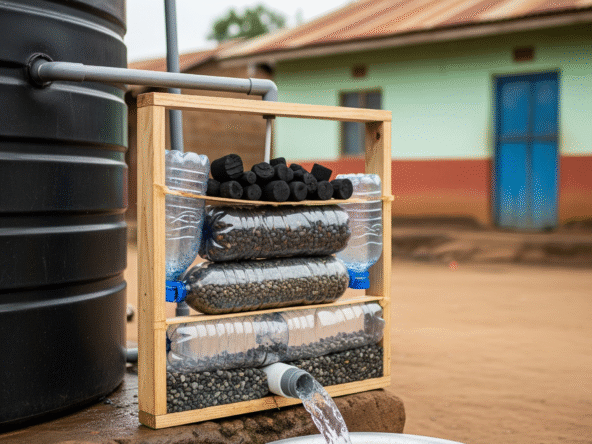Rainwater harvesting is gaining traction across Kenya as homeowners seek reliable alternatives to municipal supply and expensive boreholes. But while most homes install gutters and high-capacity plastic tanks, many overlook a crucial component first-flush diverters.
This inexpensive system ensures your rainwater is filtered at the first point of contact, before it enters your storage tanks. It’s especially important for homes using roof catchment, IBC tanks, or underground gravity-fed systems.
Let’s explore the best diverter options, how they work, and how to build one that fits your home’s needs.
What Is a First-Flush Diverter?
A first-flush diverter is a device that captures and diverts the initial runoff from a roof during the start of a rainstorm. This first flush contains the highest concentration of:
- Dust and dirt particles
- Bird droppings and rodent waste
- Insect remains and tree debris
- Industrial soot (especially in urban areas)
Once the initial dirty water fills the diverter, it automatically redirects the cleaner water into your main storage system whether it’s a gravity-fed underground tank, IBC tank, or elevated plastic tank on a DIY stand.
Why Every Rainwater System in Kenya Needs One
Kenyan roofs collect a range of contaminants between rains. Without a diverter, these pollutants go straight into your tank—causing murky water, bacterial growth, clogged filters, and smelly taps.
A well-installed diverter:
- Reduces cleaning frequency of your storage tanks
- Improves compatibility with greywater reuse
- Extends lifespan of plumbing and solar pumps
- Prevents sediments from blocking overflow piping systems
Most Effective First-Flush Diverter Designs
1. Vertical Pipe Diverter with Ball Seal
How it works:
This vertical PVC pipe fills with the first dirty water. A floating rubber ball rises and seals the pipe once it’s full, forcing the cleaner water to bypass it and enter the tank.
Materials:
- 75mm or 100mm PVC pipe (1–3 meters long)
- Tee junction
- Rubber or plastic ball (floats and seals inlet)
- Drain plug at the base
Best for:
- Rooftop rainwater systems
- IBC tanks
- Dusty rural or semi-urban environments
2. Horizontal Diverter with Manual Drain
How it works:
Dirty water is directed into a horizontally mounted chamber or pipe. A valve at the base allows you to drain the water manually after every rain event.
Pros:
- Affordable and easy to build
- Ideal for small homes with occasional rainfall
Cons:
- Requires consistent manual emptying
This system works especially well in gravity-fed layouts where space is limited.
3. IBC Tank as a First-Flush Collector
In larger setups, you can use a full-size IBC tank as a dedicated pre-treatment chamber. It collects significant first-flush water before routing the rest through a filter into the main tank.
Benefits:
- Holds 100–300+ litres of dirty runoff
- Easy to clean and reuse
- Perfect for flat roofs or commercial buildings
Bonus: You can also repurpose this tank for irrigation or compound cleaning once the debris settles.
4. Integrated Gutter Diverters
These are compact, pre-fabricated diverters fitted directly inside your gutter or downpipe. They use internal flaps or trays to discard the first few litres of rainwater.
Ideal for:
- Urban homes with limited space
- Low-slope rooflines
- Quick retrofits on existing systems
How Much Water Should You Divert?
A good rule of thumb is to divert 0.5 to 2 litres per square metre of roof surface. For example:
| Roof Area | Suggested First-Flush Volume |
|---|---|
| 80 m² | 40 – 160 litres |
| 120 m² | 60 – 240 litres |
| 200 m² | 100 – 400 litres |
Tip: The dirtier or older your roof, the higher the volume you should divert.
DIY Diverter Materials and Tools
To build a diverter, you’ll need:
- 75mm or 100mm PVC pipe (height depends on volume needed)
- Tee joints and elbows
- Rubber or plastic float ball (for auto-sealing)
- End cap or drain valve
- Mesh screen (to keep out insects/leaves)
- Wall brackets or metal straps
You can find most of these materials at local hardware shops or jua kali yards. Total cost ranges between KSh 1,000–3,500 depending on pipe size and fittings.
Maintenance Tips
First-flush systems are low-tech, but require basic care to remain effective:
- Open the drain cap and release debris after each heavy rainfall
- Clean the ball valve or floating seal monthly to avoid sticking
- Check inlet screens and clear out trapped leaves
- Repaint any exposed PVC to protect it from UV damage
If your system is automated with float switches, link a diverter alert to prevent overfilling or silent failure.
Clean rainwater starts at the roof but first-flush diverters are what make it usable. Whether you’re collecting water in Ruaka, Narok, or Machakos, installing a diverter dramatically improves your system’s hygiene, performance, and lifespan.
Paired with pre-filtration tanks, overflow management, and regular maintenance, a diverter can transform your tank from a backup option into a primary water source.
Explore More Practical Systems:


